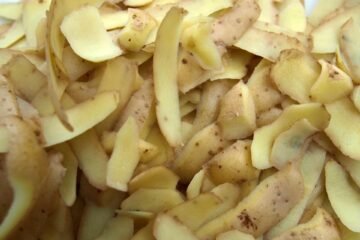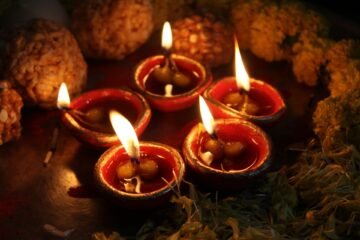Braj… Imagine a world steeped with the emotions of community and giving. Where food is not eaten without first feeding the cows outside the house. Where no one who comes home is sent back on an empty stomach. Where food, like God, is both loved and revered.
Imagine a world like that…
And welcome to Braj.
This article consists of the food memories of Ruchir Matholiya whose family has resided in Mathura since three generations. Let’s read his childhood experiences living in one of the oldest lanes of Mathura to understand the essence of Braj cuisine.
The Socio-Cultural Inspiration
A lot of us believe that food is worship. But these words have never been truer than in the famous Braj region centering around Mathura Vrindavan. The Braj region, also known as Brij or Brijbhoomi, is a 5000 sq. km area between Palwal district of Haryana, Mathura district of Uttar Pradesh and Bharatpur district of Rajasthan. It is spread on both sides of the Yamuna river and is part of the central Ganga-Yamuna doab region.
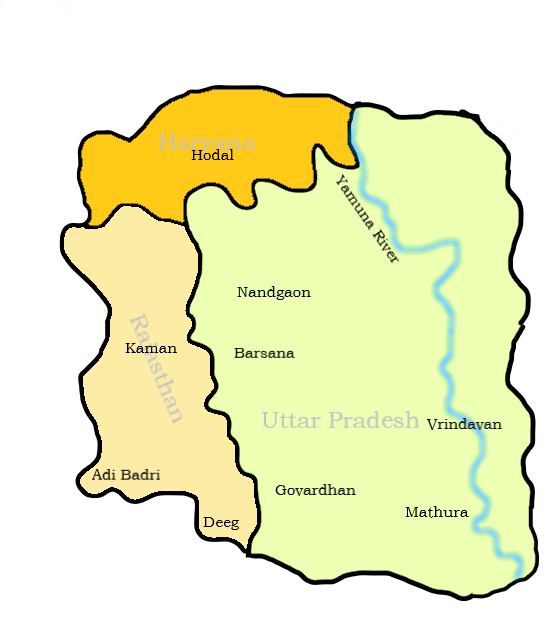
This region is believed to be the birthplace of Hindu god Krishna. The famous scenes of Krishna’s childhood pranks, his penchant for butter, his time as a cowherd, his love for Radha, etc. are all scenes etched into the landscape of Mathura Vrindavan. Even today Krishna plays a big role in defining the Braj culture, by becoming an inseparable part of its community and cuisine.
Characteristics of Braj Cuisine
1. Satwik Food
Inspired by the cowherd God Krishna, Braj cuisine revolves around religion and cows. One of the most defining characteristics of Braj cuisine is that the food is simple satwik food, where no garlic or onion is used. A number of reasons exist behind this practice, one being that both of these are medicinal ingredients (tamsik in Ayurveda) and not suited for regular use. There is also the widespread belief that onion and garlic tend to overpower the dish and take away from the natural taste of vegetables.
Whatever the reason, the major point is that all food cooked in the old houses of Mathura Vrindavan is treated as prasad (holy offering) and onion and garlic are not considered to be suitable ingredients for the same. Even the commonly found streetside chaatwalas and restaurants do not use onions and garlic in their chaat. The few who do to cater to the special demands of tourists, keep chopped onion and garlic separately on the side in a black polythene. However, onion and garlic are never mixed into the main food made even in commercial establishments. To compensate for garlic, asafoetida, or heeng, is used heavily in the cuisine.
The food is also lighter than its northern and eastern counterparts of Rampuri and Awadhi cuisines. Most tourists are astonished to note how vibrant the taste is even without the use of onion, garlic and excessive spices.
2. The Predominance of Milk
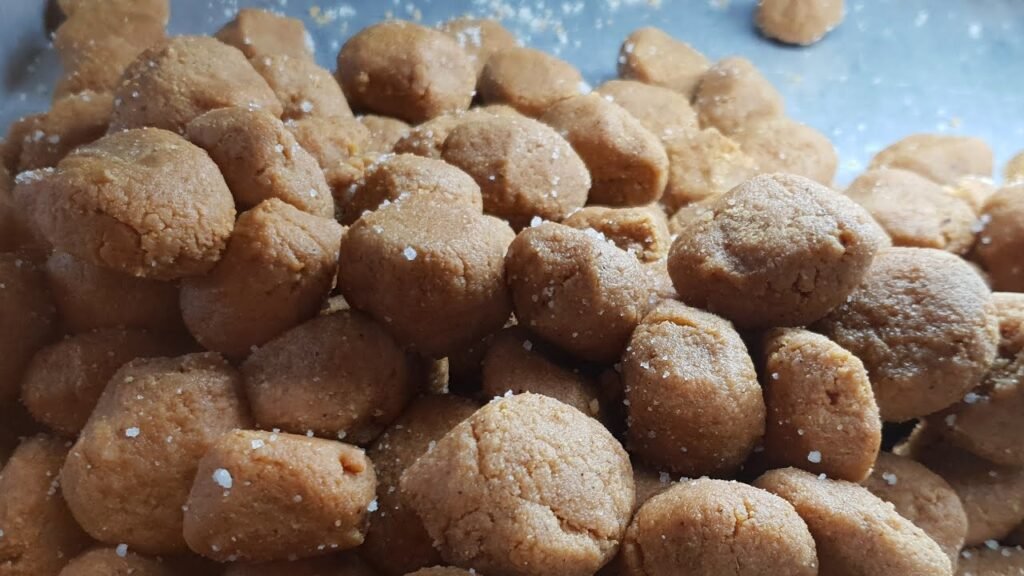
Cows played a big role in Lord Krishna’s life, and so do they in the traditional Brij household. The people of Mathura Vrindavan love desserts, and most of the desserts of this region are milk-based. This includes the famous Mathura ke peda, malai ghewar, khurchan, butter toast (similar to chhena toast) and kheer mohan. Milk is also used in other forms like pure milk, curd, ghee and their derivative recipes.
Speaking of Mathura ka peda, there is an interesting story behind it. Local folklore says that there was a local halwai who was trying to make a special dessert prasad for Lord Krishna. While trying to decide what to make, he got so lost in his thoughts of his dear God that he kept stirring the milk on low steam for hours until the milk turned into a creamy thick caramelized version of itself. When the halwai came out of his trance, he realised that the milk smelled really divine. So he added some sugar and cardamom to it and shaped it into the flattened disc shapes.
And thus was born the famous Mathura ka Peda. You can find its recipe here.
3. A Touch of Chilli
Since Mathura is near Rajasthan, a lot of the local cuisine is influenced by the Rajasthani penchant for chilli. Mirchi ka achar (chilli pickle) is a frequent accompaniment to the pooris and kachoris served at home. The famous Braj breakfast of crispy kachori is incomplete with a thin potato curry with kali mirch pakoris. One of the innovative village dishes is a unique mirch aur cheeni ka paratha (chilli and sugar paratha).
4. ...And A Dollop of Chatpatapan
I don’t know how to describe the word chatpata in English. I just know it is the eye-closing, tongue-tingling and mouth-watering sensation one feels after the first bite of chaat.
People of Braj love chatpata food! It is a part of dishes like khatte meethe kaddu, the sweet and sour pumpkin mash served with kachori. The souring agent in this dish can be raw mango powder, tamarind, or even the seasonal raw mango. Other famous chatpate food items include the tawe wali sabjiyan served in local weddings as well as sweet and sour melodies of chaats, which we’ll talk about in a while.
Culture of Giving
1. The Animal Amicability

Food is also an intangible part of the Braj culture of giving. One of the prime examples of mutual co-existence is the traditional relationship between the cows kept in old Braj houses and the household. Earlier, most houses in Mathura had one to four cows at home. These cows were beloved family members and were lovingly given pet names. The milk given by the cow was considered as a gift from them, not an entitlement. And hence, no pressure or unnatural means were used on the cow to give milk. Unlike modern dairying, the calf’s right to drink its mother’s milk was above and beyond that of the household’s, and no calf was deprived of its right to drink its mother’s milk just for commercial human gains.
Even today, when many houses do not have cows of their own, no food is eaten in the house before the first two rotis cooked for lunch and dinner are not offered to a nearby cow along with the day’s sabji (vegetable) and some sugar. For this purpose, the local gaushalas release their cows into the streets during specific times of the day. Old Braj houses have been feeding specific cows for so long that some cows open the gates of the house on their own with their horns and demand their two rotis by themselves! Not only cows, now even monkeys have become regular visitors to the homes. These monkeys were earlier found only in the Kans Kila area of Mathura, but are now found all over the town as their natural habitat got overtaken by the rapidly increasing population.
2. The Santity of Saints
‘Sai itna dijiye jaamein kutum samaye.
Main bhi bhooka na rahun, sadhu na bhooka jaye’
— Kabir
(God, give me only that much material possession that I am able to take care of my household, as well as any godman who comes to my house)
Be it animal or human, no one who came home to a Braj household left on an empty stomach. The household would ensure that they fed the guest as much as they could afford to. In earlier times, sadhus also visited houses regularly. They never asked for money, but were always fed as much as possible by the family members. Today, unfortunately this practice has almost stopped after some crimes were committed by some fake sadhus.
The spirit of giving was not just restricted to religion, but also to community. Ruchir remembers that even as late as ten years ago, when he would be cycling to places far off from home, there was a level of comfort in knocking at an unknown home and asking for water. In fact, even if one did not ask for it, some elderly community member was bound to call out,
‘Lala, baithja. Akele kahan jayega!’
(Son, come and sit down. Where will you go alone!)
And that’s how Ruchir, and many others like him, formed a bond with the community and its food. No matter where a person who has had a Braj upbringing goes, nobody can take away these pure memories and cultural tehzeeb from them.
Food and Community
The feeling of community is strong in Braj, and some food dishes are a symbol of specific community events.
1. Bhandara
Take bhandara, for example. Bhandare are commonly found in Mathura Vrindavan where free meals are offered to the community after a big event at a temple or home. Almost everyone hosts a bhandara, be they lavish ones with kachoris and sabji, or simpler ones with khichdi and mewa. No matter the host, there are two very special dishes related to bhandare. The first is Gadd ki Sabji, where a number of vegetables are mixed and cooked and freshly ground spices are then mixed into it just before serving. The second is the unusual sounding dish called ‘Sannata’. Sannata means silence in Hindi, and this drink of curd blended with digestion-aiding spices like cumin, black salt and asafoetida is meant to silence your stomach after all the heavy food eaten at the bhandara. Here’s the recipe for a special tandoori style of sannata which you can make with an old diwali diya!
2. Chaupal
Just like bhandara, another community event in braj is the chaupal. Rarely found nowadays, chaupal were discussions held under the shade of trees. We have often seen such images in movies and books. However, in Braj, chaupal had some specialities. Anybody and everybody was free to join the discussions, regardless of profession or gender. Also, the discussions were never political, but revolved around philosophy— jeevan, mrityu, moksha. And lastly, the food. All participants sat under the shade of the large trees and enjoyed a glass full of cold lassi.
3. Chhappan Bhog
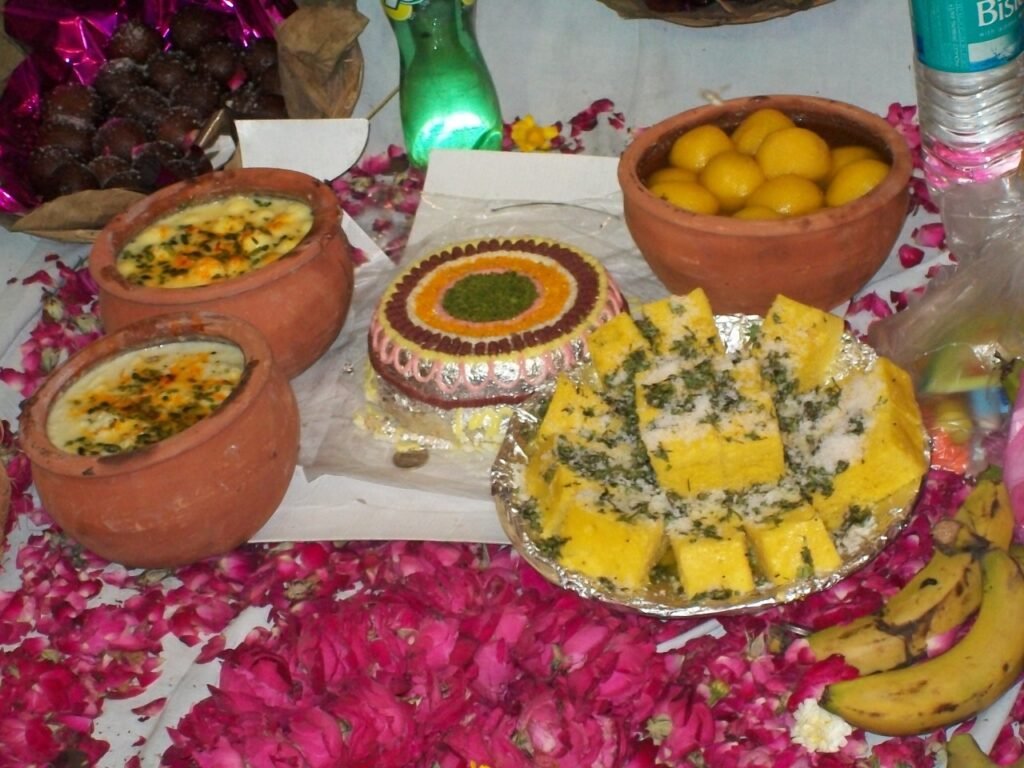
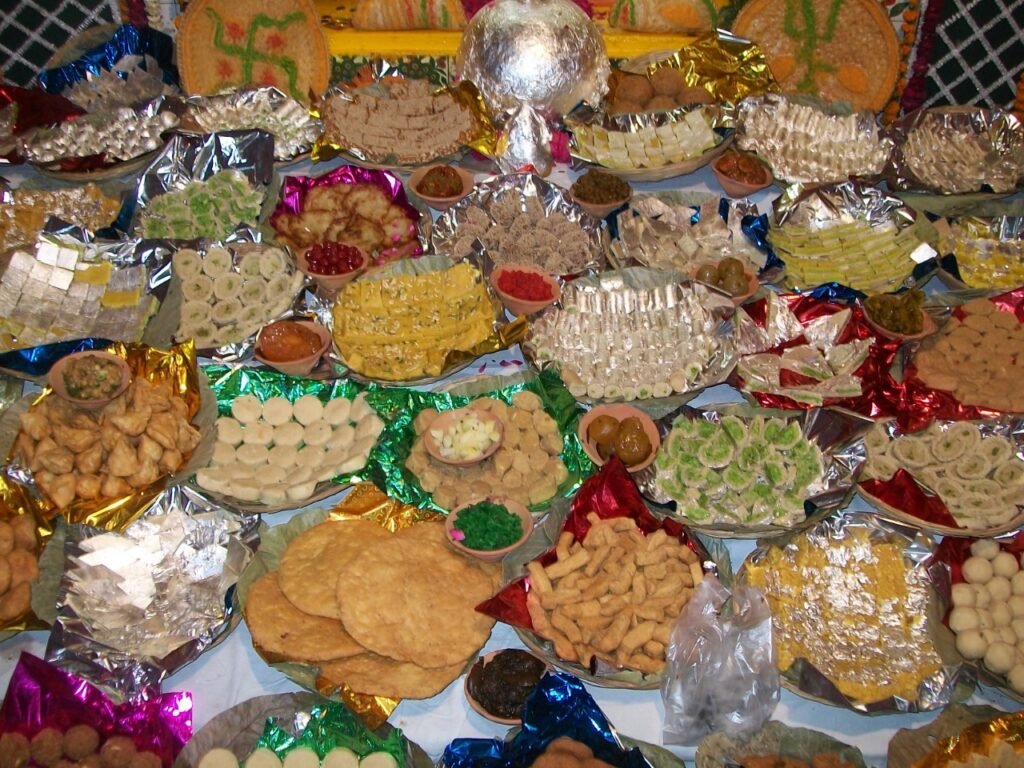
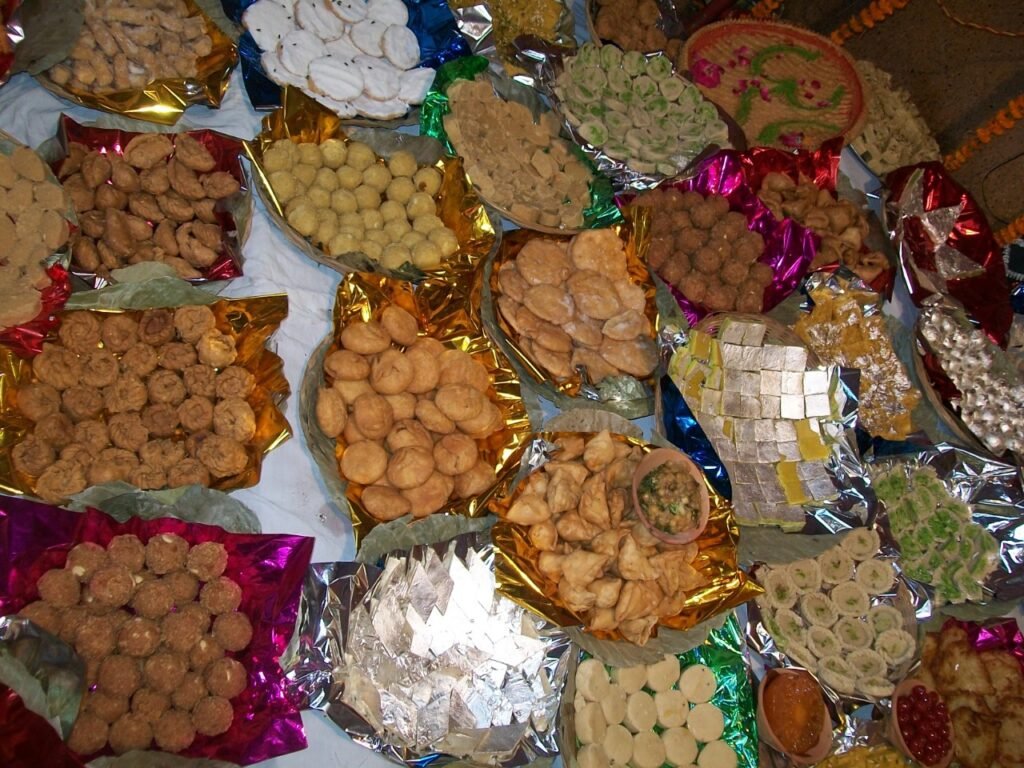
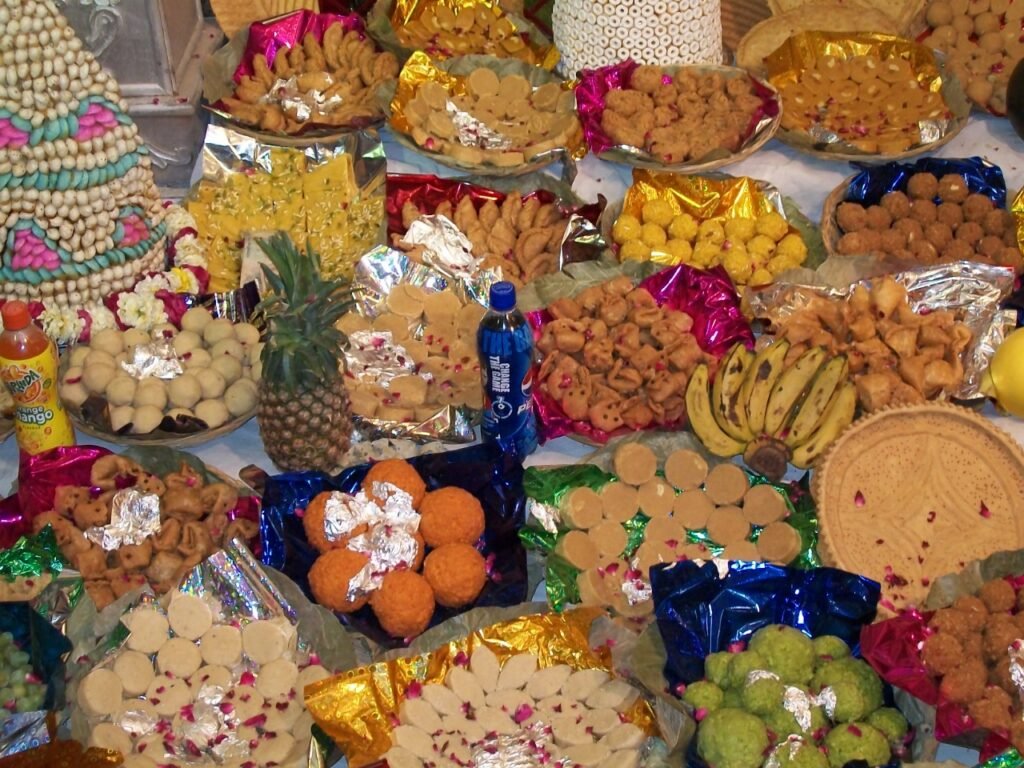
Bhandara and chaupal play big roles in the Braj community, but perhaps the biggest example of food in the community is the famous Chappan Bhog. Chappan means 56, and bhog means offerings. As per Hindu belief, a young Krishna once saw his community preparing for a grand feast to appease Lord Indra. They believed that this would bless them with rains and reap them a good harvest.
However, Krishna believed in Karma and felt that the community should just do their duty without any expectation of returns or worries about consequences. So he dissuaded them from doing the prayer and the feast.
This angered Indra, who decided to flood the region with continuous torrential rain. To save his community, Krishna lifted the Govardhan parvat of Mathura district on one finger for seven days to give shelter to his people. During this time, Krishna, whose mother fed him eight times a day, did not eat at all. So after Indra gave up, and Krishna put down the mountain, his people fed him 56 dishes.
To this day, in gratitude for this act, the people of Mathura Vrindavan offer bhog to Krishna for seven days every year. As per ancient Indian belief, food must be eaten once in each of the eight pahar of the day. Hence, eight dishes are offered to Krishna for seven days, making a total of chhappan bhog. Each house has an idol made of cow dung in their house, to which they offer the bhog. As per their saksham, they also contribute as much as possible to the local temple near their house. And hence, every temple also has their own chhappan bhog contributed by the local community.
Chhapan bhog is offered to Lord Krishna a day after Diwali on Govardhan Pooja. The 56 dishes vary from region to region, but may consist of seven types of cereals, fruits, dry fruits, vegetables, sweets, drinks, namkeen and pickles each. The sequence of dishes also varies from milk-based, to besan-based, to salty and then cardamom.
After seven days of heavy festive food, the next day’s meals consist of a simple khichdi. No wonder, look at the chhappan bhog in its entirety!
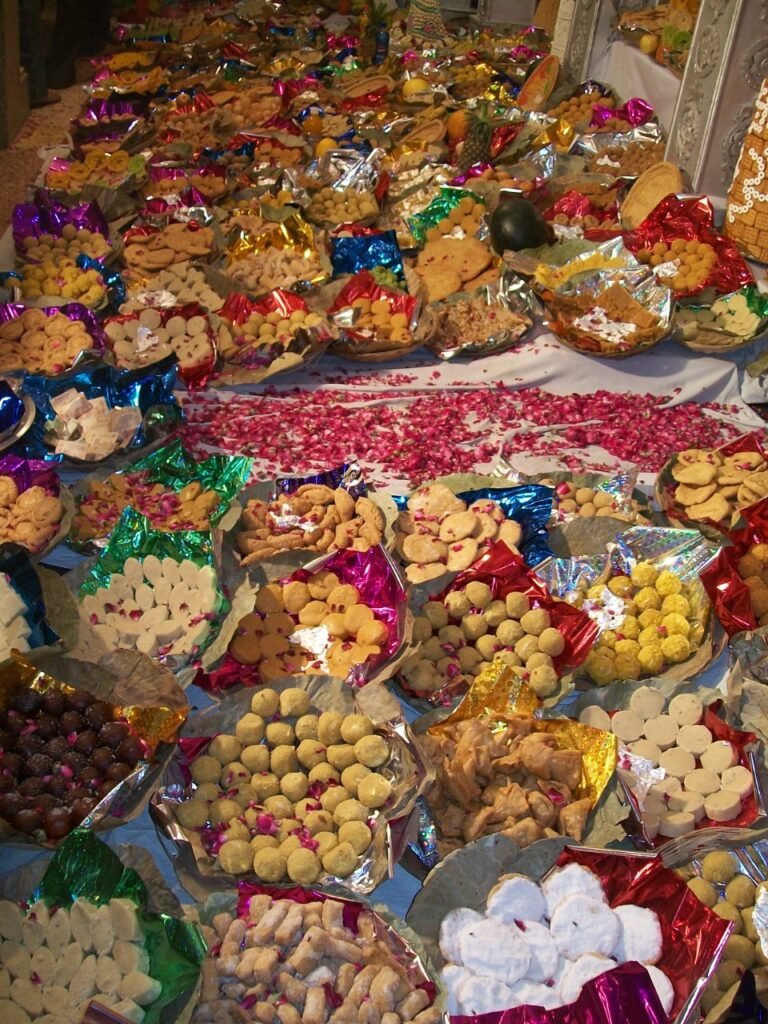
The Seasonal Cycle of Street Food
A host to the tourists of Govardhan Parikrama, the Braj region of Mathura Vrindavan has a lot of famous street food dishes. Interestingly, some dishes are annual and available throughout the year, while some are seasonal.
Annual Dishes
1. Kachoris
Among the annual dishes is the famous Braj breakfast of kachori. The kachori is a thick kachori with a filling of urad dal. The thicker kachori is usually served with a trio of boondi raita, aloo gravy with kali mirch pakore and kashiphal ki sabji (pumpkin). Hing kachori with aloo gravy and jalebi, especially that of Oma Pehelwan Kachori wale, is a famous breakfast in the town of Mathura. The kachori here has a filling of moong dal flavoured with asafoetida and saunf, and is served with aloo jhol, an aloo curry cooked in ginger broth with green chillies. Adding to this spicy combo are decadent jalebis cooked in desi ghee. Sometimes a combination of jalebi and aloo jhol is also served here!
2. Bedmi Poori
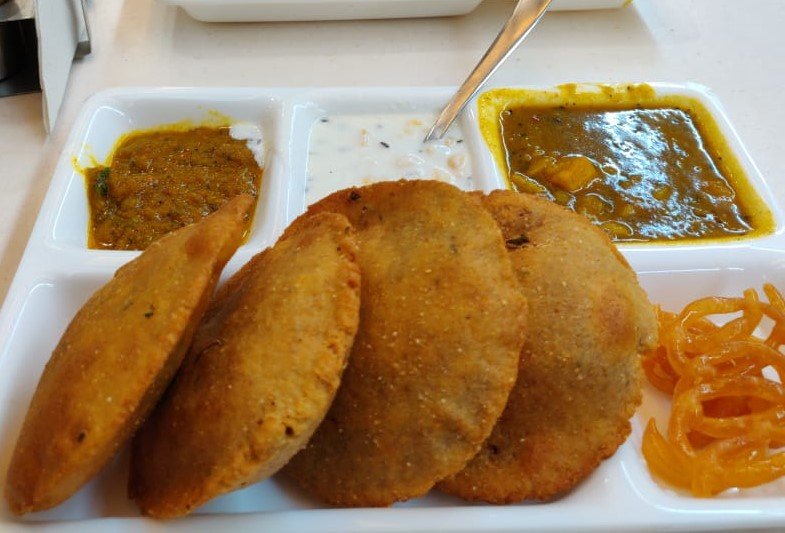
On a similar note is the bedmi poori, a thinner, flakier bread, which is a speciality of this region. This is served with a very thin gravy called dubke wale aloo. Dubke wale aloo is called so, because the gravy is extremely thin, and one has to dive into the gravy with their poori in order to find a piece of potato. Dubke wale aloo are a concoction of street vendors who would get up early morning to make their food. They would quickly mash up potatoes, add in spices and water and let the gravy simmer while they concentrated on their main dish, the pooris. Hence, the gravy is simple in terms of ingredients, but very flavourful. Here’s an interesting recipe for bedmi poori and dubke wale aloo.
3. Aloo Ki Jalebi
A very unique dish here is the aloo ki jalebi. Yes, you read that right. It’s a jalebi made of aloo! An iconic shop in Jatipura part of Mathura sells these thick jalebis made of potato. Also known as angoori jaleba, these are midway between jalebi and imarti in terms of thickness. But the taste is just as scrumptious, and a bit more!
4. Milk-Based Desserts
Milk-based desserts like rabri are omnipresent in Braj. A regional speciality is the khurchan, to make which milk is boiled slowly to the edge of being completely condensed. The thick milk layer at the bottom of the vessel is scraped off and made into khurchan, an iconic street food of the region. The khurchan found jamna-kinare near Dwarkadhish temple is supposed to be the best in Mathura.
Another important milk-based dish is the makhan mishri, said to be the favourite food of Krishna. This is a dish of sweetened fluffy white butter topped with mishri, with the subtle aroma of the clay pot it is served in permeating through it. Makhan mishri is served as prasad in Banke Bihari temple of Vrindavan.
5. Chaat
As we discussed before, the average Braj person loves tanginess. They love chaat, the most famous of which is bhalle. But beware! Bhalle in Mathura Vrindavan means a crispy aloo tikki, and not the dal vada found in other parts of North India. This crispy aloo tikki can be plain, or stuffed with paneer and pomegranate, and served with curd and spiced white matar. Again, the gol gappas in Mathura are called tikkia. These are crispy fried balls of maida, sooji or whole wheat flour. These are served filled with sweet tamarind water, or hing-flavoured water.
6. Migrant Influences
Some other permanent Mathura dishes can be found in Bengali haat, a place where Bangladeshi migrants had settled in ages back. This area has specialities like different types of samose and mangode (moong dal, potato and cauliflower pakoris served with green and sweet chutney and hing masala). The Deeg and Nagar areas have a sweetish flatbread made of besan and dry fruits called momthal. The Gujarati influence in the area has introduced street food dishes of khaman, dhokla and poha.
Winter Specialities
While a lot of the dishes above like kachori, khurchan and rabri are more enjoyable and hence, popular, in the cold winters of Braj region, the main winter specialties are the gajar ka halwa and garam doodh. Carrot halwa is the same recipe as that found in the rest of the country, but the milk-loving Braj people add loads more of mawa or khoya over it.
The video above is a very entertaining version of the serving style of kadhai milk from Agra. 🙂 Garam doodh, or Kadai doodh, is hot milk served with thick cream, saffron and dry fruits. This milk is heated in an iron kadai from dawn to dusk, and served in both iconic shops and local weddings. Brijwasi shop’s badam milk is also a famous variant of the same.
Monsoon Specialities
The famous food of Mathura in the monsoon season, during the times of shraadh and sawan, are dal-based jalebi variant called imarti and mawewala ghewar. While Rajasthan is famous for its ghewar dessert, a crispy cake made of maida and soaked in sugar syrup, the Braj variant is more creamy with extra layers of malai and dry fruits on it.
Summer Specialities
The summer street food specialities of Mathura Vrindavan are very simple dishes, digestive in nature. The first famous one is Chacche ki Shikanji. The others are the curd-based shrikhand and lassi. Most of these dishes are coolants designed to aid disgestion as well as much needed energy.
***
And with that, we draw this article to a close for now. After months of the Covid lockdown, my conversation with Ruchir took me to another world- that of Old Mathura. I could visualize the excitement in the community during the times of Chhappan Bhog. I could feel the love the people feel while feeding docile cows. And I could smell the aroma of freshly fried kachoris and jalebis.
With this article, Ruchir and I have tried to share some of that Braj magic to you. Hope you like it and cherish the memories of a place which seems to be a home away from home.
From The Food Memories Of:

Ruchir Matholiya is a business consultant working in Düsseldorf (Germany). He has spent his entire childhood in Mathura where his family has lived for three generations. He believes Mathura is an inextricable part of his being, and he carries the essence of his culture wherever he goes.



